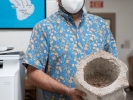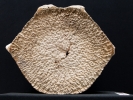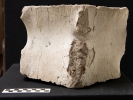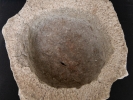
Anthropology
Check our anthropology FAQ for information about artifacts and more. Our Chumash Life pages for teachers and students provide a basic introduction to some aspects of traditional daily life.
- Anthropology
- Rocks & Fossils
- Invertebrates
- Vertebrates
- Botany
- Astronomy
- Fungi
- General
- Recently Asked
Chumash whale mortar
I am reading The Noontide Sun. In the book by Arlene Benson based off Stephen Bowers. He says he found two mortars. Carved from whale vertebrae. Did these make it to the SBMNH? Very curious to see what they looked like as it is something we normally don't see.


Curator Response
Hi Joshua,
Thanks for asking about these interesting artifacts. We don’t have the whalebone mortar collected by Bowers mentioned in the book, but we do have some other whalebone mortars in our collections. Two smaller examples can be found on display in Chumash Life here at the Museum (we think from our correspondence with you that you may have seen them there before—other folks can look for them with other artifacts from the Channel Islands, near the tomol display). We’re attaching pictures of a larger, more impressive mortar collected by then-Museum Director Ralph Hoffmann on the Channel Islands in 1925.
It’s made from a large baleen whale. All the processes (the parts that stick out) have been removed or have worn away, so it’s difficult to tell much more. It could be from a Blue Whale, Fin Whale, Humpback Whale, or something else more rare.
Although archaeologists classify these as “mortars” because of their shape, it’s unlikely they were used to grind anything, since doing so would result in a lot of bits of bone ending up in whatever people were trying to grind. We also don’t usually see the particular kind of wear you might expect from this use.
So we don’t know exactly what these were used for, but we do know whales are significant in Chumash coastal culture. A stranded whale could feed a village for a substantial period of time. There were people known as “whale dreamers” who were thought to possess the power to lure whales to the shore and therefore confer a great food source on their community. (A whale effigy probably used as a charm by a whale dreamer is among the artifacts in the current Maximus Gallery exhibition.) Whale bones were used for a variety of implements and architectural uses, including pry bars used to harvest abalone, and possibly as structural supports for some houses. You can learn more about the Chumash and other Native Americans’ relationships to whales from this 2020 talk.
We hope you find this information helpful and we thank you for your patience,
Curator of Anthropology John R. Johnson, Ph.D., Associate Curator of Anthropology Brian Barbier, M.A., and Curator of Vertebrate Zoology Krista Fahy, Ph.D.





